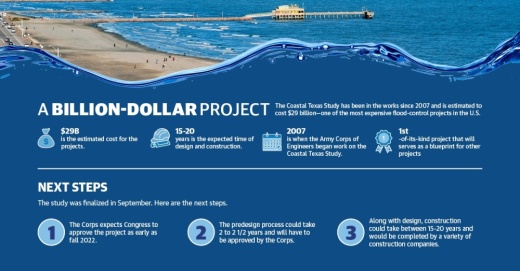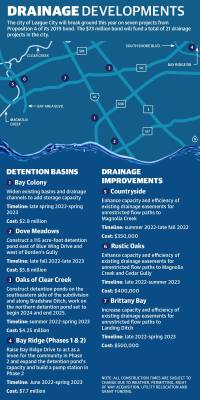The Gulf Coast Protection District, an entity aimed to leverage funding for flood control projects, was created by the Texas Legislature last summer. Now, officials are considering how the district can help fund flood mitigation projects along the Texas coast.
Additionally, the Army Corps of Engineers is awaiting approval for funding from Congress on a $29 billion proposal that aims to reduce flood damage along the coast. The plan proposes things such as flood walls, levees, enclosures and dune nourishments, said Michael Braden, chief of the mega project divisions for the Army Corps.
“All of these projects really came out of the necessity that the frequency of these storms is ramping up and we need to better protect our coastline,” Braden said.
Meanwhile, seven drainage and detention projects in League City will break ground in 2022. The projects are part of League City’s 2019 bond program, which included 21 flood protection and drainage improvement projects, which were brought forth under the $73 million Proposition A.
“The drainage projects are neighborhood specific; they’re construction intensive,” City Manager John Baumgartner said. “Since they’re so widespread, they benefit the neighborhoods one by one.”
City staff is also focusing on advancing watershed studies related to Hurricane Harvey in 2022, staff said.
Regional mitigation projects
In September, the Army Corps released a $29 billion proposal outlining projects that aim to reduce damage if a storm such as Hurricane Ike were to hit the Texas coast again.
The Army Corps then sent the proposal to Congress with the goal for Congress to approve the project and cover 65% of the project cost. If approved, the design process could begin as early as the fall with funding becoming available in 2023. If the Army Corps receives federal funds, it would still need a 35% local match from a nonfederal sponsor—in this case, the GCPD.
The GCPD was created to function as a nonfederal sponsor to help fund the Coastal Texas Study, according to Francisco Hamm, deputy chief of public affairs for the Army Corps. The GCPD approved a letter of intent in mid-2021 in collaboration with the Army Corps for the Coastal Texas Study.
To help fund its 35% match, the district plans to use state funding or resilience bonds, in which companies reimburse the cost, instead of proposing a tax rate on the district’s residents. The GCPD can pay as the project moves forward or repay it over 30 years after the project finishes, GCPD Executive Director Nicole Sunstrum said.
The Coastal Texas Study projects could take between 15 to 20 years to complete and would serve as a template for future projects across the country, according to Braden.
Meanwhile, League City partnered with multiple cities and agencies in late 2019 to fund the $1.5 million Lower Clear Creek and Dickinson Bayou Watershed Study. The study, which was released in March 2021, proposed more than $1.6 billion in regional drainage solutions, including detention ponds and an underground flood tunnel.
The city is seeking funding for Phase 2 of the study, which would determine a cost/benefit analysis for the projects, Baumgartner said. To fund the phase, League City applied in August for the Water Resources Development Act grant through the Army Corps, city staff said.
The $1.5 million WRDA grant is part of a bill requiring congressional approval, which Baumgartner said city officials hope to hear about this spring. If approved, the city could receive funding this fall to begin Phase 2, which could take up to two years to complete, city staff said. The results would help guide stakeholders toward projects to implement first, but it would not provide funding.
“We’re optimistic we’re going to find a path forward that we can afford as a region and that will provide lasting benefit within the watersheds,” Baumgartner said.
Local bond plans
Aside from flood mitigation projects targeting Clear Creek, League City will begin construction on seven drainage projects from its 2019 bond to improve drainage in neighborhoods.
The neighborhoods of Bay Ridge, Dove Meadows, Countryside, Rustic Oaks, Oaks of Clear Creek, Brittany Bay and Bay Colony will see much of the construction this year, city officials said. Projects vary from adding detention ponds and improving storm sewers to adding outflow areas to internal drainage channels.
Baumgartner said these neighborhoods were prioritized by the bond because they flooded during Hurricane Harvey in August 2017.
Bay Ridge resident Marika Fuller said the neighborhood’s streets often flood during heavy rain, but the detention pond backed up during Harvey, flooding about 90% of the community’s more than 400 homes.
While work on Phase 3—the first portion—of the Bay Ridge project started in March 2021, construction is set to begin in late summer and June on phases 1 and 2, respectively, Director of Engineering Chris Sims said.
Phase 1 includes raising Bay Ridge Drive to act as a levee for the community and push water into nearby ditches; Phase 2 will expand the detention pond’s capacity and build a pump station, Sims said.
Fuller said Bay Ridge’s drainage has improved as Phase 3 moves forward. Phase 3, which will finish in late summer, includes increasing the capacity of drainage channels and storm sewers in the neighborhood.
“The water drains faster out of the streets. ... It takes more rain to get the streets to flood,” she said. “We can see that it’s a difference, that things are changing for the better.”
Designs on Phase 4, which will include widening Gum Bayou, are ongoing. Resident Dave Bowman, who has lived in Bay Ridge for more than 40 years, said he believes the Gum Bayou project will work together with the other phases to provide significant relief to the neighborhood.
“[The work has] actually been extremely helpful, so far, but it’s only a piece of the picture,” he said.







